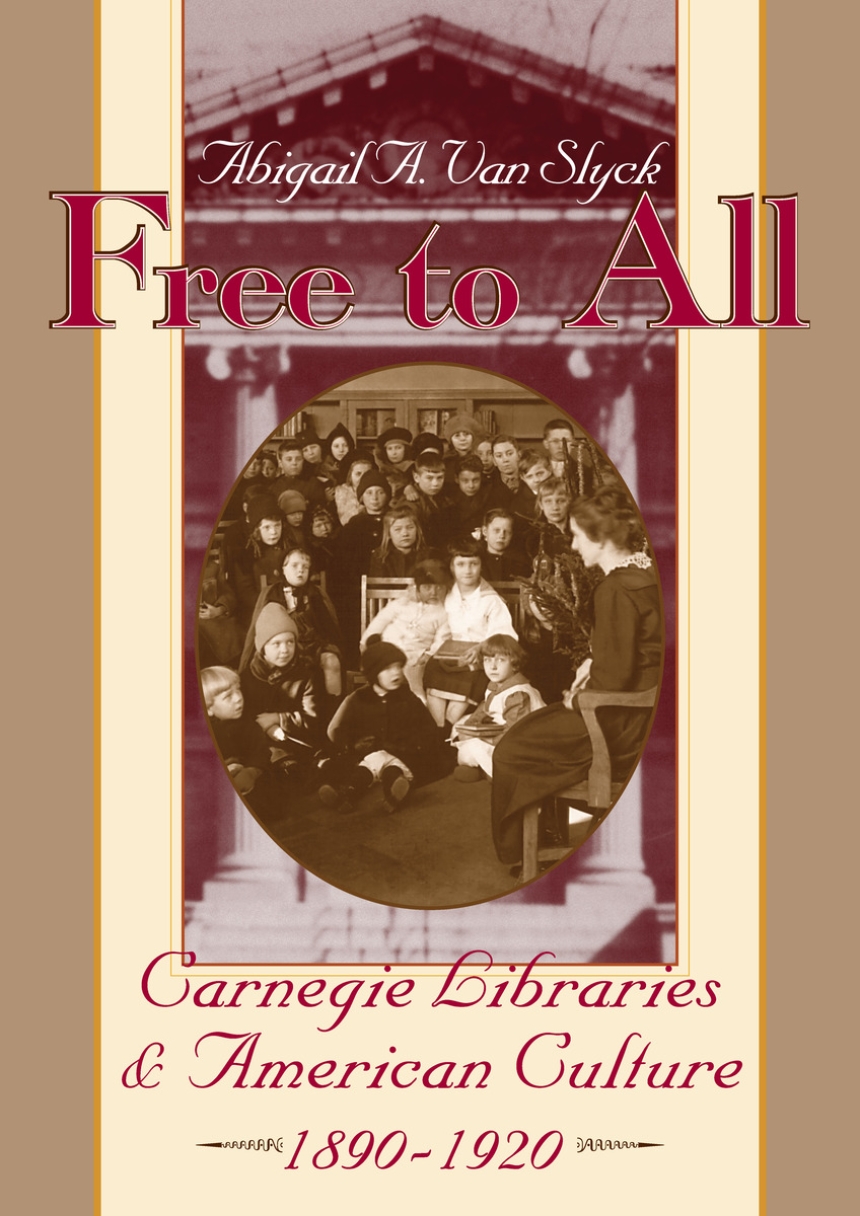Free to All
Carnegie Libraries & American Culture, 1890-1920
Familiar landmarks in hundreds of American towns, Carnegie libraries today seem far from controversial. In Free to All, however, Abigail A. Van Slyck shows that the classical façades and symmetrical plans of these buildings often mask a complex and contentious history.
"The whole story is told here in this book. Carnegie’s wishes, the conflicts among local groups, the architecture, development of female librarians. It’s a rich and marvelous story, lovingly told."—Alicia Browne, Journal of American Culture
"This well-written and extensively researched work is a welcome addition to the history of architecture, librarianship, and philanthropy."—Joanne Passet, Journal of American History
"Van Slyck’s book is a tremendous contribution for its keenness of scholarship and good writing and also for its perceptive look at a familiar but misunderstood icon of the American townscape."—Howard Wight Marshall, Journal of the Society of Architectural Historians
"[Van Slyck’s] reading of the cultural coding implicit in the architectural design of the library makes a significant contribution to our understanding of the limitations of the doctrine ’free to all.’"—Virginia Quarterly Review
"The whole story is told here in this book. Carnegie’s wishes, the conflicts among local groups, the architecture, development of female librarians. It’s a rich and marvelous story, lovingly told."—Alicia Browne, Journal of American Culture
"This well-written and extensively researched work is a welcome addition to the history of architecture, librarianship, and philanthropy."—Joanne Passet, Journal of American History
"Van Slyck’s book is a tremendous contribution for its keenness of scholarship and good writing and also for its perceptive look at a familiar but misunderstood icon of the American townscape."—Howard Wight Marshall, Journal of the Society of Architectural Historians
"[Van Slyck’s] reading of the cultural coding implicit in the architectural design of the library makes a significant contribution to our understanding of the limitations of the doctrine ’free to all.’"—Virginia Quarterly Review
294 pages | 79 halftones, 42 line drawings, 6 tables | 6-5/8 x 9-3/8 | © 1998
Architecture: American Architecture
History: American History
Table of Contents
Figures
Graphs
Table
Acknowledgments
Introduction
One - Giving: The Reform of American Library Philanthropy
Librarians vs. Architects
Andrew Carnegie Enters the Philanthropic Game
Carnegie’s Reform of American Philanthropy
Defining "The Modern Library Idea"
Designing the Modern Library
Carnegie’s Reform of American Library Architecture
Redefining the Nature of Library Use
Conclusion
Two - Making: The Marketing of Library Design
The Culture of Professionalism
The Library Bureau and the Modern Library
The Impact of the Carnegie Library Program
Conclusion
Three - Taking: Libraries and Cultural Politics, Part I
Cultural Politics in Larger Cities
The Impact of the Carnegie Library Program
Building the Central Library
Building Branch Libraries
Conclusion
Four - Taking: Libraries and Cultural Politics, Part II
Cultural Politics in Smaller Towns
Carnegie’s Reception in Small-Town America
Male and Female Visions of the Library
The Temple in the Park
Conclusion
Five - Working: The Feminization of Librarianship
Engendering American Librarianship
Engendering Library Design
Transcending the Limits of the Gendered Work Station
Conclusion
Six - Reading: The Experiences of Children as Library Users
Coming of Age in the Small-Town Library
Claiming New Space in Urban Branches
Conclusion
Postscript
Appendix 1: Notes on the Erection of Library Buildings
Appendix 2: Carnegie Libraries Sampled in Table 4.1 and Graphs 4.1-4.5
Notes
Bibliography
I. Primary Sources
II. Secondary Sources
Index
Graphs
Table
Acknowledgments
Introduction
One - Giving: The Reform of American Library Philanthropy
Librarians vs. Architects
Andrew Carnegie Enters the Philanthropic Game
Carnegie’s Reform of American Philanthropy
Defining "The Modern Library Idea"
Designing the Modern Library
Carnegie’s Reform of American Library Architecture
Redefining the Nature of Library Use
Conclusion
Two - Making: The Marketing of Library Design
The Culture of Professionalism
The Library Bureau and the Modern Library
The Impact of the Carnegie Library Program
Conclusion
Three - Taking: Libraries and Cultural Politics, Part I
Cultural Politics in Larger Cities
The Impact of the Carnegie Library Program
Building the Central Library
Building Branch Libraries
Conclusion
Four - Taking: Libraries and Cultural Politics, Part II
Cultural Politics in Smaller Towns
Carnegie’s Reception in Small-Town America
Male and Female Visions of the Library
The Temple in the Park
Conclusion
Five - Working: The Feminization of Librarianship
Engendering American Librarianship
Engendering Library Design
Transcending the Limits of the Gendered Work Station
Conclusion
Six - Reading: The Experiences of Children as Library Users
Coming of Age in the Small-Town Library
Claiming New Space in Urban Branches
Conclusion
Postscript
Appendix 1: Notes on the Erection of Library Buildings
Appendix 2: Carnegie Libraries Sampled in Table 4.1 and Graphs 4.1-4.5
Notes
Bibliography
I. Primary Sources
II. Secondary Sources
Index
